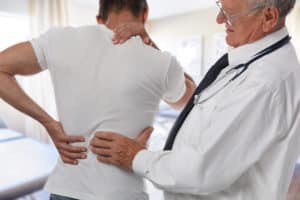Herniated Discs
Home » Personal Injury Resources » Types of Injuries » Herniated Discs

Over 16 million Americans suffer from chronic back pain. Back pain is the most common health condition that causes Americans to miss work. It is also the most frequent complaint in workers’ compensation claims.
Many of these people suffer from disc injuries. Ruptured, bulging, and herniated discs can make your spine unstable and strain the muscles and ligaments in your back. They can also pinch nerve roots, leading to pain that radiates from your back into your head and limbs.
If you suspect you’ve sustained a disc injury, it’s important to learn more about herniated discs and what compensation you can seek for disc injuries
Table of Contents
Spine Anatomy

Your spine has 24 individual bones called vertebrae. These vertebrae provide both strength and flexibility.
When you sit or stand, your vertebrae stack on top of each other to form a column. This column supports your body weight.
But the segmented nature of the spine also allows you to bend and twist your body. When you move your upper body, the vertebrae slide or turn relative to each other.
The joints between the vertebrae contain discs. These discs cushion the vertebrae so they do not crack when you run and jump.
The discs also provide a strong, smooth surface for joint movement. Without the discs, the vertebrae would grind and wear on each other as you bend and twist your back.
As their name implies, the discs have a cylindrical shape. The discs contain two different types of collagen. The outer shell, called the annulus, contains fibrous, tough collagen. The inner nucleus contains gelatinous collagen. Together, they make the discs both strong and elastic.
The spinal cord runs through the vertebrae. Between the vertebrae where the discs sit, the spinal cord branches into nerve roots. Each nerve root contains nerve fibers for a region of your body, such as your right arm or left leg.
How Ruptured, Bulging, and Herniated Discs Happen
Your discs can get injured in many ways, including:
Compression
Sudden trauma, such as a powerful compression force, can damage the discs. These compression forces can crush the discs, causing them to deform. As the discs deform, they lose some of their structural integrity. As a result, they provide less support to the vertebrae, and the deformed disc can press on nearby nerves.
A common source of compression force comes from car accidents. When your vehicle gets hit, your spine bends. This hyperextends the back and allows the vertebrae and discs to separate slightly. As you come to a stop, the stretched ligaments, tendons, and muscles pull the spine back together. As the spine rebounds, it compresses.
Overuse
As your discs get stressed, they develop microscopic cracks. Over time, these cracks accumulate. The cracks weaken the discs. They can also propagate into larger, longer cracks.
Overuse injuries often appear in people with jobs that stress their backs. Workers who lift, carry, walk, or stand for long periods can develop disc injuries through overuse.
Degeneration
As people age, their discs dry out. The collagen loses its elasticity as it loses moisture. The stiff discs can develop cracks and weaken.
Degenerated discs increase your risk of suffering a disc injury. If your discs have degenerated, they can more easily deform in an accident.
Disc Injury Types
Discs can deform in several different ways, including:
Ruptured Discs
Ruptured discs happen when the top or bottom surface of the disc develops a crack. The layers of the annulus separate, allowing the disc to deform. The disc might only deform under force. When it does, the separated layers can compress the adjacent nerve root.
Bulging Discs
Bulging discs happen when the annulus weakens but remains intact. Instead of providing support, the disc squishes into a pancake shape, with the edges of the disc bulging beyond the edges of the vertebrae.
When the disc was compressed, the spine shortened, pulling on the ligaments holding the spine together as well as the back muscles and tendons.
The bulge formed by the deformed disc can also press on the nerve root that branches near it.
Herniated Discs
Herniated discs happen when the fibers of the annulus separate. The pressure on the disc causes the nucleus to squeeze out of the disc between the fibers. The protrusion or herniation can compress the nerve root adjacent to the disc.
Symptoms of Ruptured, Bulging, and Herniated Discs
The symptoms of a disc injury will usually include back pain and instability. You may also have a stiff back, and the pain might limit your range of motion.
If the damaged disc compresses a nerve root, you may experience additional symptoms. Pressure on a nerve causes inflammation. As the nerve and the tissue around it swell, the nerve will generate pain signals. It may also misfire or drop nerve signals.
Damage to the nerve root can cause symptoms such as:
- Radiating pain
- Numbness
- Tingling
- Weakness
- Muscle spasms
The location of the symptoms will depend on the location of the ruptured, bulging, or herniated disc. A damaged disc in the neck will often cause symptoms in the shoulders, arms, hands, or fingers. A damaged disc in the lower back will often cause symptoms in the hips, buttocks, legs, feet, or toes.
Doctors have very few options for treating a damaged disc. They cannot repair the disc. But they can remove it. By removing the disc, doctors can relieve pressure on the nerve root. After removing the disc, doctors can replace it with an artificial disc or fuse the adjacent vertebrae with screws and plates.
Compensation for Ruptured, Bulging, and Herniated Discs
If your back injury happened in the course and scope of your job, you can likely seek workers’ compensation benefits. Most employers in California must carry workers’ comp insurance, and the insurer will pay benefits for on-the-job injuries.
Additionally, if your back injury happened in an accident caused by someone else’s negligence, you can seek compensation from the at-fault party or their insurer. In a negligence claim, you can seek compensation for your economic and non-economic losses.
Economic losses include your hard costs, such as medical expenses and lost income. Non-economic losses include the diminishment in your quality of life due to pain, mental anguish, and disabilities.
Contact a Los Angeles Personal Injury Lawyer to schedule a free consultation
If you suffered a herniated disk in an accident, you might be entitled to compensation. An experienced Los Angeles personal injury lawyer can help you understand your rights. Contact our M&Y Personal Injury Lawyers for a free consultation at 866-864-5477 to discuss the compensation you can seek for your ruptured, bulging or herniated discs.
